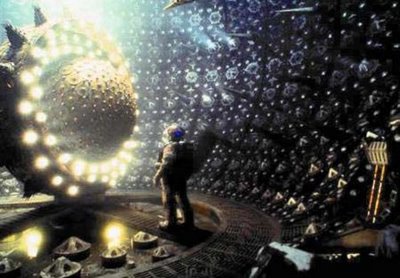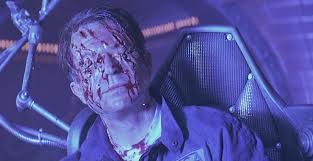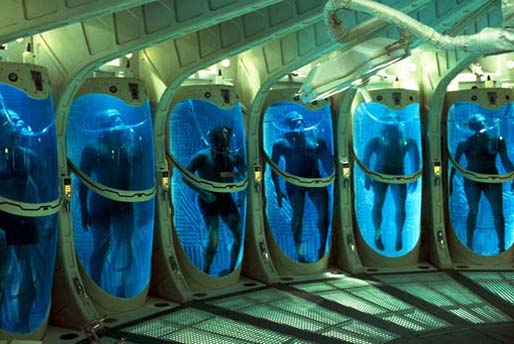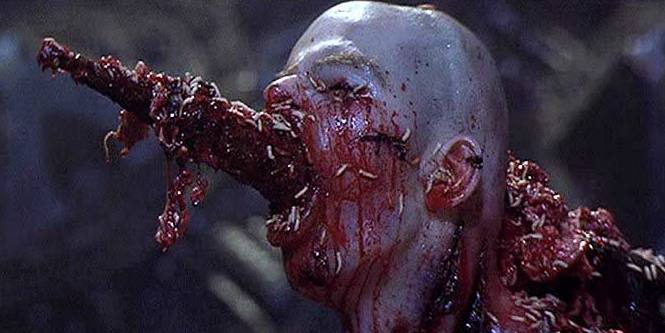 Splatter Cinema presents EVENT HORIZON (1997); Dir. Paul W.S. Anderson; Starring Laurence Fishburne, Sam Neill, Kathleen Quinlan; Tuesday, April 9 @ 9:30 p,m. (come early at 9 p.m. for photo op with a realistic recreation of a scene from the film); Plaza Theatre; Facebook event page here; Trailer here.
Splatter Cinema presents EVENT HORIZON (1997); Dir. Paul W.S. Anderson; Starring Laurence Fishburne, Sam Neill, Kathleen Quinlan; Tuesday, April 9 @ 9:30 p,m. (come early at 9 p.m. for photo op with a realistic recreation of a scene from the film); Plaza Theatre; Facebook event page here; Trailer here.
By Robert Emmett Murphy
Contributing Writer
I remember when EVENT HORIZON first came out in 1997, and specifically I remember the context of its contemporaries in SF filmmaking. A large handful of undeniable classics notwithstanding, 1990s SF filmmaking was showing clear signs of exhausting itself. There were a bumper crop of major releases with improving budgets, consistently breathtaking in their special effects and all other aspects of design, and more prestigious casts; but many, many of those films proved remarkably disappointing. Concepts that seemed ambitious were dumbed down badly, and then rendered in near incoherent form even after they were simplified. We started to pine for less bloated and more energetic B movies, but those B movies were now competing with big budget films for what was once their exclusive audience share, As a result they often got cowardly, losing their sense of “nothing to lose and everything to prove” and trapping themselves in the rehashing of major releases. The films most rehashed in that era were already a decade or more old, TERMINATOR (1984) and ALIEN (1979).
Because EVENT HORIZON did do many things right, it was ultimately far more frustrating than the very many far worse films around it. Among its virtues, the most important was that it was a SF horror film set entirely on a spaceship, but it wasn’t yet another ALIEN knock-off. In retrospect, it anticipates the recent ALIEN prequel PROMETHEUS (2012) in its tremendous narrative ambition, crippled by far from coherent storytelling, but then bolstered by strong set pieces and even better performances, only to again be undercut by not knowing what to do with the people they have wandering around the uncertain plot.
EVENT HORIZON does reference ALIEN, recapturing aspects of the look and the wonderful claustrophobic feel, and taking advantage of the more famous film’s opening ploy – our heros are traveling deep into the void in response to a distress call, and none are prepared for what they will find.
The year is 2047, and the rescue ship, “Lewis and Clark,” is piloted by an under-developed hero named Captain Miller, who is thankfully played by Laurence Fishburne, an actor whose career is notable for how many times he’s had to breathe life into under-developed characters. For the most part, his crew is similarly under-written, yet in almost every case exceptionally well-played. In fairness to the script, they do have a collective identity based on loyalty, professionalism and camaraderie that they as individuals lack.

Dr. Weir (Sam Neill) in EVENT HORIZON. Paramount Pictures, 1997
Among them is a resented stranger, Dr. William Weir, played quite well by Sam Neill. He’s the most developed of the nine significant members of the dramatis personae. Weir is carefully trying to cover how personally haunted he is. He’s suffering from nightmares of his wife’s suicide, and it was his experimental Faster-Than-Light drive (in this film, they use the hyperspace template for that future technology) is definitely at the root of the crisis, though even he can’t know how or why.
They are there to rescue the crew and research from the ship the “Event Horizon,” which seven years prior literally disappeared from the universe while testing Dr. Weir’s technology. Now, suddenly and mysteriously, it has returned. What the crew of the “Lewis and Clark” find is a gory mess, the “Event Horizon’s” crew were driven mad by their trip out of our universe and back, and slaughtered each other in a remarkable orgy of murder-suicide. Our heroes also discover the derelict ship brought something back from the other universe, an ambiguous but implacably hostile entity that can do bad things to the human mind.
“Event Horizon” is a haunted house in space, and as every school child knows, those who are most haunted entering the door are most vulnerable to the haunting once inside. The crew is right to distrust Dr. Weir, because he’s going to prove to be nothing but trouble.
The film’s most explicit references aren’t to other Science Fiction Horror films, but to Supernatural Horror films, notably THE SHINING (1980) and DON’T LOOK NOW (1973). (One film it was especially careful not to visually reference is SOLARIS (1972) because it doesn’t want to remind the audience that this over-the-top-gore-fest stole all its major plot points from that slow, meditative, art-house film.)

EVENT HORIZON. Paramount Pictures, 1997
Many (most?) of the film’s virtues are in its production which is remarkably rich and coherent through the exquisite special effects, exceptional set design and best of all, its sound editing by veteran sounds effects editor Ross Adams. The film’s suspense is heightened tremendously by the always intrusive ambient noises which never let you forgot the oppressiveness and implicit threat of a wholly artificial environment. That year, TITANIC took that (and every other) Oscar, but in comparison to this largely disregarded film, TITANIC’s sound is just a lot of smartzy bullshit.
This classy production led strength to the large number of marvelous set pieces, such as the opening scene where we are pulled back from the window of a space station and rotated as we pass through its vast structure, and keep on pulling back until the huge habitat is dwarfed by the giant Earth behind it. Another good one is the Lewis and Clark’s approach to the Event Horizon, spectacularly skimming the storm clouds of Neptune’s upper atmosphere.
Best of all was Capt. Miller’s desperate race to rescue his young crew member Justin, played by Jack Noseworthy, who is about to be sucked out of an airlock. What I was most impressed with this scene was its rare fidelity to the science, and the way it used the physical realities for dramatic effect. The imperfect, but unusually good, scientific literacy of the script strengthens the first half of the film tremendously. Unfortunately, by the last third, all concepts of natural laws and forces hves become as cartoonishly incompetent as Disney’s notorious BLACK HOLE (like ALIEN, also released in 1979, and also a clear influence on this film).
The scene that best evokes how very ambitious EVENT HORIZON was is the climax [Ed. note: SPOILER ALERT], where we have the destruction, and at same time, survival, of the title vessel, with two very different escapes, and two very different entrapments, all unfolding at the same moment. Too bad by that point the script had degenerated into complete chaos and incoherence.

EVENT HORIZON. Paramount Pictures, 1997
It seems like someone forgot to ask themselves what the golden thread really was, but who is the guilty party? Definitely director Paul W.S. Anderson, whose career is studded with ably executed, visual striking and surprisingly lavish movie-making, but who is not known for either substantive ideas or characterization. He’s been the writer and/or director on 14 films, six of which were based on video games, and another five were constructed in such a way as to facilitate video game tie-ins.
Also clearly one or both of the writers are at fault. Philip Eisner developed the initial script, but there were extensive, uncredited, rewrites by Andrew Kevin Walker at Anderson’s request.
A post-production decision to cut out 30 minutes of storytelling to make room for more special effects probably didn’t help much either.
Here’s the deal: The humans who pass through the interdimensional portal are psychicly shattered and reduced to homicidal and suicidal insanity. Implicitly, the alien who was accidently dragged through the same portal in the other direction has suffered the same. Had that been made explicit, it could’ve been explored – the monster is as much a victim as the crew, and specifically was the unintended victim of Dr. William Weir. Sympathetic monsters, like the Frankenstein monster, are horror’s most emotionally potent trope. And when the sympathy is discovered through process of rational investigation, the story stands on the firmament of legitimately mature science fiction, as in the classic STAR TREK episode “The Devil In The Dark” (1967).

EVENT HORIZON. Paramount Pictures, 1997
But instead we get a promising premise ship-wrecked by what is inevitably evoked whenever a script is peppered with phrases like “the ultimate evil” and “something infinitely more terrifying than Hell;” and a future spaceship crewed by English-speaking scientists start spontaneously babbling Church Latin and decorate their cabins with cabalistic runes painted in blood.
Probably the best guide to how terribly it all went wrong was what was done to the two best developed characters:
Lt. Peters (Kathleen Quinlan) is one of only three who gets any kind of back-story, and unlike Capt. Miller and Dr. Weir, her history isn’t evoked with excessive melodrama or ham-fisted exposition. Moreover, Quinlan provides, hands-down, the film’s best performance. She also gets killed before contributing anything to the plot. ARE YOU KIDDING ME! That’s not the character you treat as cannon fodder! Joely Richardson, as the wholly forgettable Lt. Strark who somehow manages to survive to the final credits, should’ve been cannon fodder. I suspect age-ism; Quinlan was 43 at the time, compared to Richardson’s 32, making her better prepared to run around in her underwear.
Then there’s Dr. Weir, so ably played by Neill until the script stops making sense. After that, he’s transformed into an utterly ridiculous monster. An important plot point is that Weir, though he is most vulnerable to the influence of the alien, hasn’t been through the interdimensional gate. He’s stalked, like Dr. Frankenstein, by the consequences of his defiance of nature. In the end, he is the alien’s super-human puppet, and a lot of the stuff coming out of his mouth is completely inexplicable if he hasn’t already been over to the other side. The film evokes demonic possession as an excuse, but it’s a poor excuse because there was no honest effort to tie that concept to the already well-established and fascinating environment, or the already clearly established mechanics of interdimentional travel. It just kind of leaps head first into the realm of mid-1980s straight-to-video NIGHTMARE ON ELM STREET knockoffs.

A gorier moment in EVENT HORIZON. Paramount Pictures, 1997.
EVENT HORIZON was a financial bomb, recouping less than half its $60 million dollar budget domestically. It temporarily derailed the director’s career, but he made a comeback by studiously avoiding all smartness ever since (he’s the main guy behind the RESIDENT EVIL film franchise). It was also brutalized by the critics, many of whom had a lot of fun making it out to be much worse than it was. I imagine Stephen Hunter rubbing hands and cackling with glee as he wrote this:
“If you want to have that EVENT HORIZON experience without spending the seven bucks, try this instead: Put a bucket on your head. Have a loved one beat on it vigorously with a wrench for 100 minutes. Same difference, and think of the gas you’ll save.”
Now that’s just plain mean.
The late, great Roger Ebert was far more on target (as usual):
“It’s all style, climax and special effects. The rules change with every scene…But then perhaps it doesn’t matter. The screenplay creates a sense of foreboding and afterboding, but no actual boding.”
The retro/cult market eventually redeemed this film. It’s almost perfect for that nitch, because when forewarned, the film’s self-destructiveness is actually pretty amusing. Also, cult cinema has always thrived on the ambitious failures, the shoulda, coulda, woulda’s of Hollywood, and this movie is all of them wrapped up into one.
Robert Emmett Murphy Jr. is 47 years old and lives in New York City. Formerly employed, he now has plenty of time to write about movies and books and play with his cats.
 PEGGY GUGGENHEIM: ART ADDICT (2015); DIR. Lisa Immordino Vreeland; Documentary; Opens Wed. Nov. 27; Landmark Midtown Arts Cinema; Trailer here.
PEGGY GUGGENHEIM: ART ADDICT (2015); DIR. Lisa Immordino Vreeland; Documentary; Opens Wed. Nov. 27; Landmark Midtown Arts Cinema; Trailer here.















